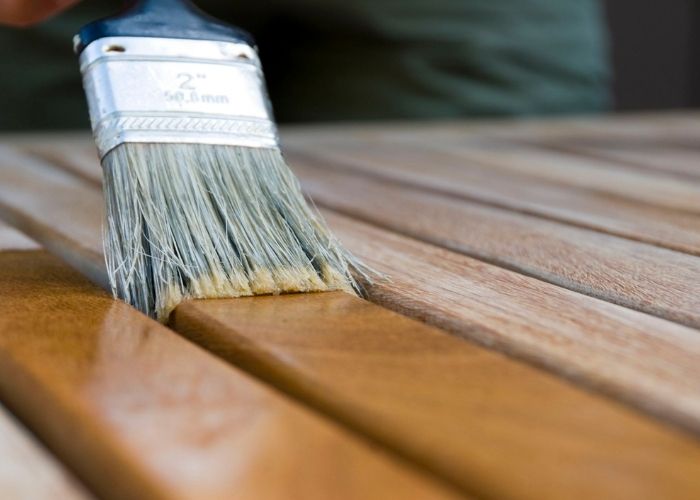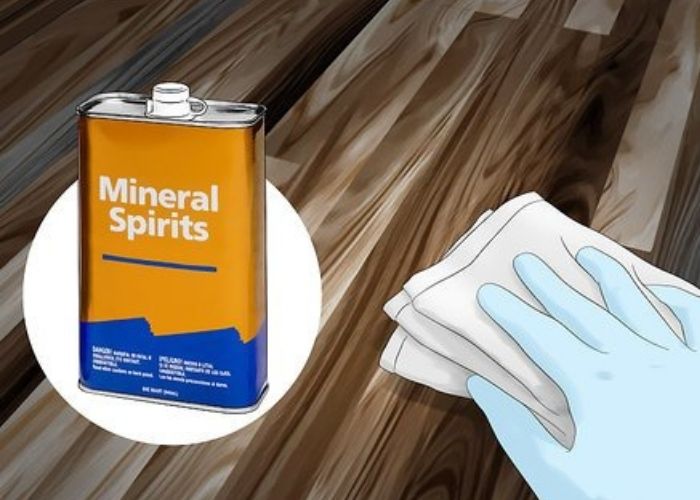How Clean A Wooden Dresser Before Staining
Learning how to make clean wood after sanding before staining is a significant step towards achieving a shine wood stain stop. Staining wood guarantees its longevity by protecting the wood against water damage. Information technology also enhances the beauty of the wood grains by adding a shine.
Sanding is a crucial role of the wood preparation process. This process is washed on every slice of wood piece of furniture, hardwood floor, or any wood projection before applying stains. Sanding ensures a smooth surface, and the woods pores are ready to soak in the stain.
Every bit an expert woodworker, here are some tried-and-true ways you tin use to remove loose dust from your wood afterward sanding.
Read along for the details.
How to Clean Woods Later on Sanding Before Staining
Brainstorm by blowing the grit using an air compressor, vacuum the grit, or brush information technology off using a dust brush. Then, wipe the surface using a material dampened in either water or mineral spirits. Yous can also employ a tack cloth to clean your sanded woods earlier staining.
How to Make clean Wood After Sanding Earlier Painting or Staining
Staining needs to exist washed in an environs free from dust since dust particles can be a major setback when targeting a smooth finish on your wooden surface. This guide volition show you the simple methods yous tin can utilize to tackle a dusty situation.
Ensure you are working in a well-ventilated area, dress up in coveralls, wear your mask and goggles when necessary. Sanding is messy. Cleaning sanding dust off the woods is messier: that's why you demand to wear your protective gear.
Tools and Materials y'all will demand
- Dusting brush
- Vacuum
- Air Compressor
- Tack cloth
- Mineral spirits
- Denatured alcohol
- Trisodium Phosphate
- Clean cloths
- Mask, goggles, coverall
Using a Dusting Brush

Sanding can create a huge junk of dust inside a short time, whether y'all are using manus-held sandpaper or a power sander. That's why the easiest method to remove dust is to castor information technology away with a dusting castor.
You lot can likewise improvise and utilize a clean and dry out paintbrush to tackle the same dust problem. This method is best suited for wood furniture and hard-to-reach areas of the wood.
The steps
Step 1: Use a soft-bristled brush to brush the sand dust away from the surface.
Aim to remove as much equally possible. Remember to use gentle brushing strokes not to lift the dust and cause them to fly and besprinkle farther.
Step 2: Collect the accumulated dust in a dustpan and dispose of it.
Step 3: Wipe the surface clean using a textile dampened in water.
Using a Vacuum
A vacuum cleaner is an essential item in most households. Other than using information technology to go on the dwelling house clean, you can bring information technology to your workshop, and it will aid you continue your space cleaner. Most electric sanders have a vacuum installed in them.
This method would be for yous if you sanded your wood surfaces using a palm-sandpaper or a sander without the vacuum.
The Steps
Footstep 1: Switch on your store vacuum (preferably a soft vacuum hose nozzle) and hover it on areas covered with loose grit.
Step 2: Ensure the vacuum has sucked upward all the dust on and around the wood surfaces.
Step 3: Wipe the remaining grit from the wood using a cloth soaked in mineral spirits or denatured booze.
Using Air Compressor
Using an air compressor is another easy way to remove dust particles from the wood after sanding. This tool does the contrary of vacuum: information technology blows the sawdust dust abroad from the wood's surface. If you accept it around, endeavour using it in the uncomplicated steps below.
The steps
Step 1: Prepare the high-pressure level air on your compressor, and then switch it on
Step 2: Aim the compressor blower nozzle at an angle of about 45-caste.
Step 3: Let the compressed air to flow out and blow away the dust from your sanded area.
Step 4: Requite your surface a concluding wipe with a damp cloth.
Using a Tack Textile
First things first: a tack cloth is a specialized viscous fabric designed to wipe loose dust, clay, and lint from wooden surfaces before painting, staining, or any other course of finishing is done. Some other mutual name for tack cloth is cheesecloth.
You tin can buy tack clothes from local hardware stores. Nonetheless, you can make your cheesecloth if yous're interested in DIY. Showtime, soak a 12-inch cheesecloth in a fleck of Tung oil. And then keep it in a zip-lock plastic bag to prevent it from drying upon repeated usage.
The Steps
Step one: Fold the tack in whichever shape works for you, so employ it to wipe off the dust in back and forth motions.
Step 2: Utilize a cleaner side of the cloth one time one side gets clogged with accumulated dust. Ensure no grit is left lingering on the surface.
Using Mineral Spirits to Remove Dust

Mineral spirits are one of the everyday items in virtually woodworkers' workshops or tool kits. It's a multi-functional item essential to most woodworking projects: It can exist used as a paint thinner for oil-based paints or for degreasing annihilation oil based on wood.
In this detail instance, you can use mineral spirits on forest before staining to remove every grain of grit from your furniture, floors, and other wood projects. In addition, it t makes sure to leave your wood surface squeaky make clean during the final stages of wood preparation for a flawless woods finish.
How to clean wood with mineral spirits after sanding
Step 1: Remove every bit much dust as possible using a dust brush, a clean, dry rag, a vacuum, or a compressor.
Step 2: Saturate a clean cloth in mineral spirits. You can also pour some spirits on the woods.
Stride iii: Wipe the wood surface using a gentle back and forth motions. Work along the wood grain. Utilise firm strokes to pick up every loose grit particle.
Step 4: Utilise more mineral spirits to a cleaner office of the cloth and go on wiping. Repeat the process equally many times as needed on every inch of your dusty wood.
Step five: Utilise a make clean, dry out cloth to run passes on the surface. This is to ensure the forest is now free of mineral spirits and sawdust residues.
The woods might appear darker in color because of the number of mineral spirits used. But, as the wood dries, the original wood color will be restored.
Using Denatured Alcohol
You can apply denatured booze to remove sandpaper grit from the wood surface. This alcohol evaporates fast, which ways it won't discolor the wood. It's rubber to apply on whatever wood project idea.
The Steps
Step 1: Soak a clean material in denatured alcohol.
Stride ii: Wipe the grit away from the wood using the soaked cloth. Apply every bit much booze and several clean cloths equally necessary.
Step 3: Ensure the concluding wipe comes clean, meaning all the sanding residues have been lifted, and the wood is ready for what's next.
Using Trisodium Phosphate
Trisodium phosphate (TSP) powder cleaner can be mixed with water following the manufacturer's instructions, or you tin can buy one in liquid course.
The Steps
Pace 1: Dust off the excess sanding dust from the wood using a grit brush or vacuum.
Step 2: Saturate a make clean material in TSP liquid.
Step three: Wipe the forest to remove every remaining dust.
Read:
How to lighten dark stained woods piece of furniture
Best Stains for Maple Woods
Cleaning Wood Earlier Staining FAQs
How practise y'all clean wood later on sanding before staining?
Brushing, bravado, or using a vacuum attachment bristle to remove sanding grit is an first-class identify to brainstorm. Even so, to get rid of every residue, yous volition demand to use a tack material. Alternatively, you tin wipe off the remaining dust using a make clean cloth soaked in water, mineral spirits, denatured alcohol, or Trisodium phosphate.
Can I use mineral spirits to clean wood before staining?
Cleaning wood with mineral spirits earlier staining is a common practise. Mineral spirits brand an first-class cleaning agent for wood, especially when preparing to finish it by staining or painting. After you have sanded the wood, soak a fabric in mineral spirits. Then wipe down your dusty surface, and you are good to go.
Practice you take to clean wood before staining?
You have to clean wood before staining. This is because staining does little to hide any imperfections on the wood: exist information technology dust, grease, scratches, or dirt. And so if you lot want a shine finish, always sand the wood clean and evenly, then remove dust before y'all apply a stain finish.
What do y'all clean woods with after sanding?
There're several tools used to clean woods later on sanding. The most accessible tool is a painter'due south dust brush, a vacuum, or an air compressor. Then wipe the surface with a lint-free cloth soaked in mineral spirits. The mineral spirits are known for their power to clean whatsoever surface in readiness for painting or staining.
Do yous need to clean wood before staining?
You lot demand to clean wood before staining if you want to achieve a flawless stain finish. The best manner to even out the wood is to sand information technology down then clean it before applying any stain. Avert being too rough while sanding since the wood might thin out or end up with conspicuous scratches which can't be concealed with stains.
How practise you prepare wood for staining?
Sanding the forest using a sanding block or orbital sander is the best way to prepare wood for staining. Yous can always start with 120-grit sandpaper on refinished woods surfaces. Using lower dust sandpaper type makes the wood feel and wait crude. In effect, the wood absorbs more stains: creating a dark stained wood.
More: How to Stain Acacia Wood
How to Clean Forest Before Staining Summary
Now that you have learned how to clean wood after sanding before staining, y'all can get ahead and prepare the woods. Once information technology's gear up, and so choose and utilise the best stains for your wood.
The methods we've talked most are dependent on each other. Get-go, you remove excess dust by brushing, bravado, or vacuuming, and then wipe to remove every concluding piece of droppings. Every woodworker understands how wood preparation is deadening but yields gratifying results.
Which other methods tin you lot utilise to remove grit from wood? Engage us in the comments section below.
Source: https://woodworkingclarity.com/clean-wood-after-sanding-before-staining/
Posted by: wilsonliche1953.blogspot.com


0 Response to "How Clean A Wooden Dresser Before Staining"
Post a Comment